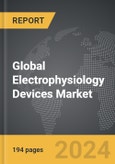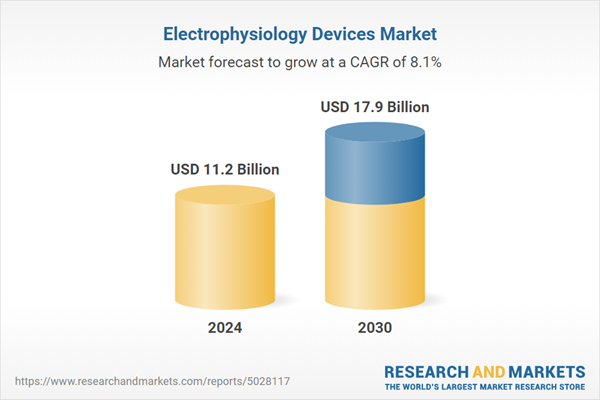The global market for Electrophysiology Devices was valued at US$11.2 Billion in 2024 and is projected to reach US$17.9 Billion by 2030, growing at a CAGR of 8.1% from 2024 to 2030. This comprehensive report provides an in-depth analysis of market trends, drivers, and forecasts, helping you make informed business decisions. The report includes the most recent global tariff developments and how they impact the Electrophysiology Devices market.
Segments: Product (Electrophysiology Ablation Catheters, Electrophysiology Diagnostic Catheters, Electrophysiology Laboratory Devices, Access Devices, Other Products); Indication (Atrial Fibrillation (AF), Atrial Flutter (AFL), Atrioventricular Nodal Reentrant Tachycardia (AVNRT), Other Indications).
Geographic Regions/Countries: World; United States; Canada; Japan; China; Europe (France; Germany; Italy; United Kingdom; and Rest of Europe); Asia-Pacific; Rest of World.
The analysts continuously track trade developments worldwide, drawing insights from leading global economists and over 200 industry and policy institutions, including think tanks, trade organizations, and national economic advisory bodies. This intelligence is integrated into forecasting models to provide timely, data-driven analysis of emerging risks and opportunities.
Global Electrophysiology Devices Market - Key Trends and Drivers Summarized
How Are Electrophysiology Devices Enhancing Cardiac Diagnostics and Treatment?
Electrophysiology devices are transforming the landscape of cardiac care by enabling precise diagnostics and effective treatment of heart rhythm disorders. These devices, including diagnostic catheters, mapping and recording systems, and complex ablation devices, play crucial roles in identifying and managing conditions such as atrial fibrillation, flutter, and ventricular tachycardia. By providing detailed insights into the electrical activity of the heart, electrophysiology devices help pinpoint the origins of arrhythmias and guide interventions that can restore normal heart rhythm. This targeted approach improves the accuracy of treatments and can significantly enhance patient outcomes by reducing symptoms, preventing complications, and sometimes curing the underlying condition.What Innovations Are Enhancing the Functionality of Electrophysiology Devices?
Innovations in electrophysiology devices are focused on improving the accuracy, safety, and patient outcomes of cardiac arrhythmia management. One of the key advancements includes the development of high-definition mapping systems that offer clearer and more detailed visualizations of the heart’s electrical activity, enabling more precise ablations. Integration of advanced imaging technologies such as intracardiac echocardiography (ICE) with electrophysiology studies provides real-time, detailed anatomical views during procedures, enhancing safety and efficacy. Additionally, the use of robotic navigation systems allows for more precise manipulation of catheters, reducing the physical strain on physicians and potentially decreasing procedure times. Wearable technology and remote monitoring devices also represent significant advancements, extending the capabilities of electrophysiology beyond the hospital setting by continuously tracking heart function and detecting arrhythmias in real-time.How Do Electrophysiology Devices Impact Healthcare Efficiency?
Electrophysiology devices significantly impact healthcare efficiency by enabling faster, more accurate diagnoses and by providing more effective treatments. The use of these devices often leads to a direct improvement in the management of patients with arrhythmias, reducing the need for repeated hospital visits and long-term medication use. Advanced electrophysiology technologies streamline procedures and can reduce the risks associated with invasive treatments, leading to shorter recovery times and lower complication rates. This efficiency not only improves patient throughput but also contributes to cost savings within healthcare systems. Moreover, the ability to perform complex diagnostics and treatments in outpatient settings due to these advanced devices further reduces the economic and logistical burden on tertiary care centers.What Trends Are Driving Growth in the Electrophysiology Devices Market?
Several trends are driving growth in the electrophysiology devices market, including the increasing prevalence of cardiovascular diseases, aging populations, and technological advancements in medical devices. As global populations age, the incidence of cardiac conditions such as atrial fibrillation is rising, fueling the demand for effective diagnostic and treatment options. There is also a growing trend towards minimally invasive procedures, which have been shown to offer benefits such as reduced recovery times and lower risks of complications. This shift is increasing the adoption of sophisticated electrophysiology devices across healthcare settings. Furthermore, the integration of digital health technologies with electrophysiology, such as data analytics and machine learning, is expanding the capabilities of these devices, making procedures more efficient and improving patient management. These trends, combined with ongoing clinical research and innovations in device technology, ensure a dynamic and expanding market for electrophysiology devices, making them indispensable tools in modern cardiac care.Report Scope
The report analyzes the Electrophysiology Devices market, presented in terms of units. The analysis covers the key segments and geographic regions outlined below.Segments: Product (Electrophysiology Ablation Catheters, Electrophysiology Diagnostic Catheters, Electrophysiology Laboratory Devices, Access Devices, Other Products); Indication (Atrial Fibrillation (AF), Atrial Flutter (AFL), Atrioventricular Nodal Reentrant Tachycardia (AVNRT), Other Indications).
Geographic Regions/Countries: World; United States; Canada; Japan; China; Europe (France; Germany; Italy; United Kingdom; and Rest of Europe); Asia-Pacific; Rest of World.
Key Insights:
- Market Growth: Understand the significant growth trajectory of the Electrophysiology Ablation Catheters segment, which is expected to reach US$6.6 Billion by 2030 with a CAGR of a 9.3%. The Electrophysiology Diagnostic Catheters segment is also set to grow at 7.8% CAGR over the analysis period.
- Regional Analysis: Gain insights into the U.S. market, valued at $3.1 Billion in 2024, and China, forecasted to grow at an impressive 7.6% CAGR to reach $2.8 Billion by 2030. Discover growth trends in other key regions, including Japan, Canada, Germany, and the Asia-Pacific.
Why You Should Buy This Report:
- Detailed Market Analysis: Access a thorough analysis of the Global Electrophysiology Devices Market, covering all major geographic regions and market segments.
- Competitive Insights: Get an overview of the competitive landscape, including the market presence of major players across different geographies.
- Future Trends and Drivers: Understand the key trends and drivers shaping the future of the Global Electrophysiology Devices Market.
- Actionable Insights: Benefit from actionable insights that can help you identify new revenue opportunities and make strategic business decisions.
Key Questions Answered:
- How is the Global Electrophysiology Devices Market expected to evolve by 2030?
- What are the main drivers and restraints affecting the market?
- Which market segments will grow the most over the forecast period?
- How will market shares for different regions and segments change by 2030?
- Who are the leading players in the market, and what are their prospects?
Report Features:
- Comprehensive Market Data: Independent analysis of annual sales and market forecasts in US$ Million from 2024 to 2030.
- In-Depth Regional Analysis: Detailed insights into key markets, including the U.S., China, Japan, Canada, Europe, Asia-Pacific, Latin America, Middle East, and Africa.
- Company Profiles: Coverage of players such as Abbott Laboratories, Inc., Biosense Webster, Inc., Biotronik SE & Co. KG, Boston Scientific Corporation, CardioFocus, Inc. and more.
- Complimentary Updates: Receive free report updates for one year to keep you informed of the latest market developments.
Some of the 41 companies featured in this Electrophysiology Devices market report include:
- Abbott Laboratories, Inc.
- Biosense Webster, Inc.
- Biotronik SE & Co. KG
- Boston Scientific Corporation
- CardioFocus, Inc.
- Medtronic PLC
- MicroPort Scientific Corporation
- Nihon Kohden Corporation
- Siemens Healthineers
- Stereotaxis, Inc.
Tariff Impact Analysis: Key Insights for 2025
Global tariff negotiations across 180+ countries are reshaping supply chains, costs, and competitiveness. This report reflects the latest developments as of April 2025 and incorporates forward-looking insights into the market outlook.The analysts continuously track trade developments worldwide, drawing insights from leading global economists and over 200 industry and policy institutions, including think tanks, trade organizations, and national economic advisory bodies. This intelligence is integrated into forecasting models to provide timely, data-driven analysis of emerging risks and opportunities.
What’s Included in This Edition:
- Tariff-adjusted market forecasts by region and segment
- Analysis of cost and supply chain implications by sourcing and trade exposure
- Strategic insights into geographic shifts
Buyers receive a free July 2025 update with:
- Finalized tariff impacts and new trade agreement effects
- Updated projections reflecting global sourcing and cost shifts
- Expanded country-specific coverage across the industry
Table of Contents
I. METHODOLOGYII. EXECUTIVE SUMMARY2. FOCUS ON SELECT PLAYERSIII. MARKET ANALYSISREST OF WORLDIV. COMPETITION
1. MARKET OVERVIEW
3. MARKET TRENDS & DRIVERS
4. GLOBAL MARKET PERSPECTIVE
UNITED STATES
CANADA
JAPAN
CHINA
EUROPE
FRANCE
GERMANY
ITALY
UNITED KINGDOM
REST OF EUROPE
ASIA-PACIFIC
Companies Mentioned (Partial List)
A selection of companies mentioned in this report includes, but is not limited to:
- Abbott Laboratories, Inc.
- Biosense Webster, Inc.
- Biotronik SE & Co. KG
- Boston Scientific Corporation
- CardioFocus, Inc.
- Medtronic PLC
- MicroPort Scientific Corporation
- Nihon Kohden Corporation
- Siemens Healthineers
- Stereotaxis, Inc.
Table Information
| Report Attribute | Details |
|---|---|
| No. of Pages | 194 |
| Published | April 2025 |
| Forecast Period | 2024 - 2030 |
| Estimated Market Value ( USD | $ 11.2 Billion |
| Forecasted Market Value ( USD | $ 17.9 Billion |
| Compound Annual Growth Rate | 8.1% |
| Regions Covered | Global |









